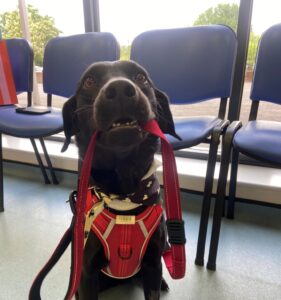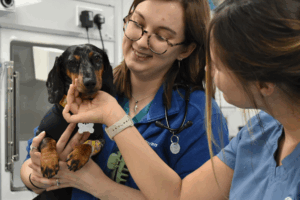February is Dental Awareness Month!
While we all believe that we do our best to keep our pets as healthy as we can, many owners underestimate the importance of dental care. Problems are often only noticed when they reach a late stage, such as severe bad breath or discomfort that’s become bad enough to put a pet off their food.
Why Is Pet Dental Health Important?
Dental disease is very common, with up to 80 per cent of dogs and 70 per cent of cats over the age of three suffering from poor oral health. This is significant for more than just cosmetic reasons. Studies have shown a direct link between poor oral health and disease of the heart, brain and kidneys.
The good news is research has demonstrated that dogs with healthy, clean teeth live longer and oral disease can be largely avoided by having a good home care routine in place.
Brushing your pets’ teeth is the best way of keeping teeth clean and free from disease. Brushing at least three times a week but ideally once a day, will help to remove plaque and build up of tartar.
I’ve Never Brushed My Pets’ Teeth Before – What do I do?
It’s just like any other form of training. Starting when your pet is young is often easier but regardless of your pets’ age, if you are planning to introduce a new dental hygiene routine, it’s best to approach it slowly.
Step 1
Start to regularly rub your pets face with your fingers and hands. When they become comfortable with this – if they aren’t already, start to very gently hold their mouths shut for a short period of time. This is done my placing your fingers on top of the muzzle and your thumb under the lower jaw.
Work towards your pet being comfortable to allow you to do this for 30 seconds, remembering to reward their positive behaviour afterwards.
Step 2
Now that you are able to gently close the mouth, you can progress to a finger brush.
You MUST use a toothpaste designed for pets as some of the ingredients in human toothpaste can be toxic to animals.
Start by applying a small amount of toothpaste to your fingertip or finger brush and very gently slide your finger under the lips to rub the paste onto the teeth. The incisors (small teeth at the front) can be very sensitive, so leave these until last when your pet is accustomed to the sensation.
Step 3
Once your pet is used to finger brushing, you can progress on to a toothbrush. One specifically designed for dogs or cats Is best.
Use the toothbrush in exactly the same way as you did previously with your finger or the finger toothbrush. Don’t worry if you see a small amount of blood on the toothbrush to begin – it is perfectly normal and should stop if you continue to brush the teeth regularly. If it continues more than a few weeks, consult a vet. Keep brushing session’s short, no more than two minutes.
What Else Can I Do For My Pets’ Teeth?
Dental Chews – Dental chews are a great way to help keep teeth clean, especially the hard to reach back ones. It’s important to choose those specifically designed to gently remove plaque. These should be used in addition to regular brushing not instead of, as chews alone are not capable of maintaining long-term oral health.
Specialist Diets – Some brands of pet food offer a range that are specifically designed to be kind to your pet’s teeth and can be used in conjunction with brushing. The biscuit size, shape and texture is formulated to provide an increased abrasive action.
If you have concerns over or would like further advice about your pets’ dental health, please don’t hesitate to call us:
St Kitts Veterinary Centre: 01252 844044
Basingstoke Veterinary Centre: 01256 844944
Crookham Park Veterinary Centre: 01252 913990
Firgrove Veterinary Centre: 01252 877799





